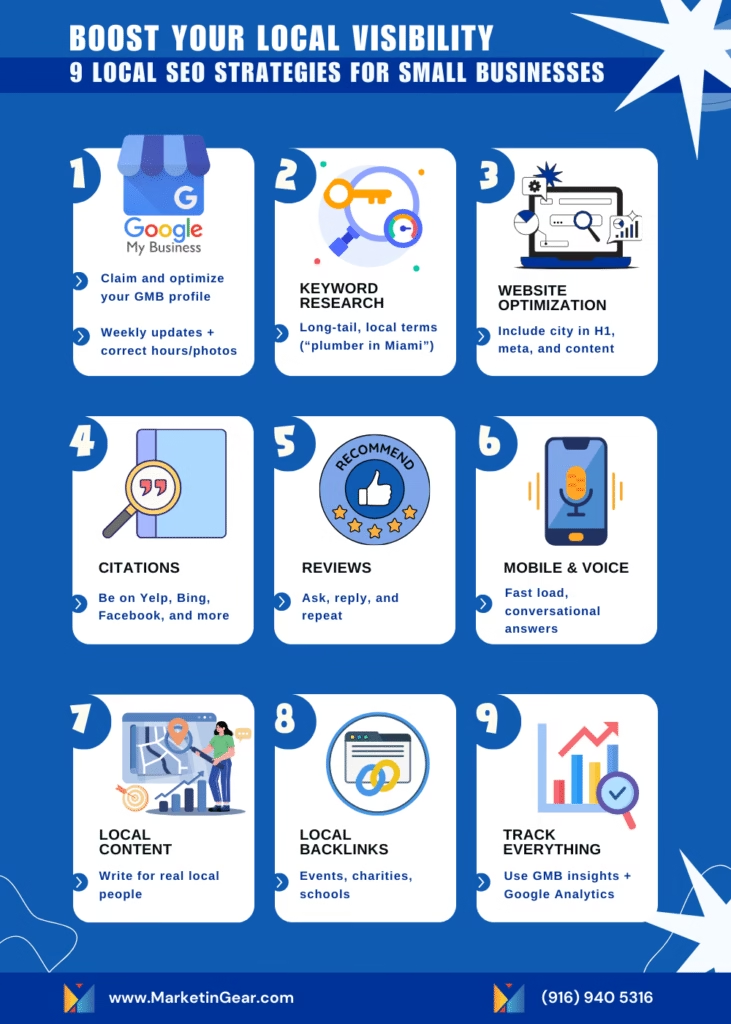Introduction: Why Local SEO Matters More Than Ever
Imagine this: you’re craving a hot slice of pizza 🍕. You whip out your phone, type “best pizza near me,” and voilà—a list of places pops up. That’s local SEO in action. It helps customers find businesses like yours exactly when they need it.
In 2025, with voice searches, AI tools, and mobile-first everything, having a strong local SEO strategy is no longer optional—it’s your digital handshake. It’s how you show up in your neighborhood, not just online.
For small businesses, especially service-based ones, local SEO levels the playing field. Whether you run a cozy salon, a neighborhood café, or a plumbing service, these strategies can help you rank higher, get found faster, and build trust locally—without needing a Fortune 500 marketing budget.

1. 📍 Claim and Optimize Your Google My Business (GMB) Profile
If there’s one thing you do today, make it this: claim and optimize your Google My Business profile.
Think of your GMB listing as the front door to your online store, even if you don’t sell anything online. It’s often the first impression a potential customer will have.
Here’s what to focus on:
- 🖼️ High-Quality Photos: Showcase your storefront, products, and smiling team.
- 🕘 Accurate Hours: Update your hours regularly, especially on holidays or for seasonal changes.
- ✍️ Keyword-Rich Description: Write a compelling business summary. Example: “Family-run Mexican restaurant in downtown Sacramento with vegan options.”
- 📞 NAP Consistency: Make sure your Name, Address, and Phone Number match everywhere online.
- 👉 Weekly Posts: Use GMB like a mini social platform—share updates, promos, events, and blog posts.
✅ Pro Tip: Businesses with complete and regularly updated GMB profiles get 7x more clicks than those with incomplete listings.
2. 🔍 Master Local Keyword Research
Local SEO success begins with understanding what your customers are searching for.
You don’t need expensive tools—just a shift in mindset. Instead of generic keywords like “plumber,” use geo-specific long-tail keywords, such as:
- “emergency plumber in Phoenix”
- “licensed HVAC contractor near downtown Atlanta”
- “affordable birthday cakes in Sacramento”
💡 Where to find ideas:
- Google Autocomplete (type in a phrase and see what shows up)
- “People Also Ask” on Google
- Google Keyword Planner (free with a Google Ads account)
- Ubersuggest (great for beginners)
✏️ Make a keyword list tailored to your business. Prioritize buyer-intent keywords—these convert better than general ones.
3. 🖥️ Optimize Your Website for Local SEO
Your website is your 24/7 salesperson—but it needs to speak to your local audience.
Here’s what it should communicate clearly:
- What you do
- Where you do it
- Why you’re trustworthy
✅ Local Optimization Checklist:
- City or Neighborhood in Key Places:
- Page Titles (e.g., Affordable Tax Services in San Diego)
- Meta Descriptions
- H1 Tags
- Homepage content and service pages
- Create Location-Specific Pages:
/plumbing-san-diego/plumbing-la-mesa
Each page should include:
- Relevant local content
- Customer testimonials
- Photos from that area
- Local service area maps
- A clear CTA (Call-to-Action)
🔧 Tip: Embed a Google Map on your contact page for extra SEO juice.
4. 🗺️ Build Local Citations and Business Listings
Citations are online mentions of your business—on directories, social media, and industry platforms—even if they don’t link to your site.
Start with these essential listings:
- Yelp
- Facebook Business
- Apple Maps
- Bing Places
- Yellow Pages
- Angie’s List
- Local Chamber of Commerce directories
📍 NAP Consistency Is Crucial
Inconsistent name/address/phone info confuses both Google’s algorithm and your customers.
✅ Use a citation management tool like BrightLocal or Moz Local to help maintain consistency.
5. ⭐ Get More (and Better) Online Reviews
Social proof is powerful. People trust reviews almost as much as personal recommendations.
Here’s how to build your online reputation:
- ✅ Ask every happy customer to leave a review
- 💬 Respond to every review—even negative ones—with professionalism
- ✨ Sprinkle in relevant keywords in your replies:
- “Thanks for loving our chimney cleaning service in Tulsa!”
🧠 Did You Know?
Businesses with 50+ recent Google reviews often outrank competitors with fewer—even if the average rating is slightly lower.
🏆 Pro Tip: Create a simple review request flow via email or text after each service.
6. 📱 Optimize for Mobile and Voice Search
Mobile and voice are no longer the future—they’re the now.
Nearly 60% of local searches happen on a phone. And more than half of smartphone users use voice search regularly.
💬 Voice search is conversational. Think:
- “Where can I get a haircut near me open on Sundays?”
- “Find a dog groomer in Sacramento that takes walk-ins.”
How to Prepare:
- Make sure your site is mobile-responsive
- Improve page speed (Google PageSpeed Insights can help)
- Use conversational language in headers and FAQs
- Answer customer questions clearly and directly
- Use schema markup (local business structured data) for better search visibility
7. ✍️ Create Local Content That Connects
To Google and your community, local content = local authority.
Types of content that work:
- Blog posts like “Top 10 Date Night Spots in Sacramento”
- Case studies: “How We Helped a Local Bakery Double Foot Traffic in 3 Months”
- Behind-the-scenes videos from events or holidays
- Staff spotlights and local business collaborations
- Community news: “Our Team Volunteered at the Sacramento River Cleanup”
🌟 Bonus: Collaborate with neighboring businesses. Interview a nearby florist or coffee shop—then cross-promote each other on your blogs or social pages (hello backlinks!).
8. 🔗 Get Quality Local Backlinks
Backlinks from relevant, trusted local sources help boost your authority in Google’s eyes.
💡 Ideas to earn them:
- Sponsor a local sports team, school, or charity (get listed on their website)
- Host or speak at local workshops or events
- Submit stories or tips to local news websites
- Be a guest on a local podcast
- Partner with local influencers or micro-creators
🎓 Even a mention on your neighborhood PTA site or local library’s business list helps.
9. 📊 Track, Tweak, and Triumph
Local SEO isn’t “set it and forget it.” It’s a cycle of optimization.
Tools You’ll Need:
- Google Analytics (to track site traffic and user behavior)
- Google Search Console (to monitor keyword performance and indexing)
- Google Business Profile Insights (to measure clicks, calls, and direction requests)
- BrightLocal (for tracking local SEO KPIs)
🎯 Monitor:
- Local keyword rankings
- Website traffic from specific cities or zip codes
- Number of GMB views and actions
- Clicks for directions, phone calls, and messages
📈 Make data-driven decisions. If one service page isn’t converting—update the CTA or rewrite the copy with fresher keywords.
Conclusion: Your Local SEO Launchpad Starts Here 🚀
Local SEO isn’t just about search rankings—it’s about being seen, being trusted, and being chosen.
For small business owners, this is your chance to connect with real people in your community—those actively looking for the exact service or product you offer.
By showing up when and where it matters most, local SEO drives foot traffic, calls, bookings, and most importantly—loyal customers.
So whether you’re just getting started or looking to improve your local strategy, the steps above form your roadmap to real-world results.
And if it all feels like too much to handle while running a business?
That’s where MarketinGear comes in. We specialize in:
- Building high-performing local SEO strategies
- Managing your GMB profile
- Crafting content that connects
- Getting you found by the people who matter most
📞 Let’s build your visibility, boost your bookings, and grow your local presence together.
Ready to become your city’s top search result?
Let MarketinGear help you make it happen.




